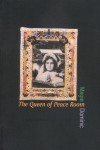The Queen Of Peace Room
by Magie Dominic
Wilfred Laurier University Press,
2002
Reviewed by Teri Marcotte
 When I pick up a book, I generally read everything on the bookís cover to learn more about whatís inside. One of the first things I read about
The Queen Of Peace Room is that it is a life story. My groans were not easily suppressed. Was I to be subjected to yet another tortuously muddled road trip through someone elseís painful past?
Skeptically, I began to read.
When I pick up a book, I generally read everything on the bookís cover to learn more about whatís inside. One of the first things I read about
The Queen Of Peace Room is that it is a life story. My groans were not easily suppressed. Was I to be subjected to yet another tortuously muddled road trip through someone elseís painful past?
Skeptically, I began to read.
The story begins with the Ms. Dominicís sojourn to a house domiciled by a group of nuns who live in the country surrounded by woods and meadows. The trip is a suggestion from a friend. An eight day retreat in a room called The Queen of Peace. A fitting title for what Ms. Dominic is prepared to accomplish. There is a need to eliminate the clutter of the past to be able to see the life that lies ahead and how she is to live it. The juxtaposition between the environment and her past is keenly described.
Somewhere, between the geography of the meadow and the complex itself, the layers of my past are
unraveling, and nothing
can stop it. The thoughts and images Iíve buried for years are rushing to the surface, wanting to be free. There is something
in the landscape of this retreat house, maybe the land itself, an ability to connect with the power of the ground and the liquid
gold alchemy of the meadow.
It is here in very concise, nondescript terms that the author lays bare her baggage that sheís toted for her fifty some odd years. The abuse at the hands of her grandfather that was known of by her parents, her epilepsy that she bore as a shameful invisible scar that would at some times save her from lifeís rough hands, the rape she suffered in her twenties that the police all but accused her of asking for, a violent marriage that gives her a daughter, and the loss of a dear friend to AIDS.
With such subtle grace, Magie Dominic paints a picture of a little girl, who becomes a woman who is simply trying to be more than just a victim in a life that just happened. Through her work as an artist, both in print and on the stage of a hole in the wall dinner theatre in New York City called the Caffe Cino, she relives or revisits the pain of her Newfoundland upbringing. She is not an embittered feminist who disparages of the evils of man. She is a quiet woman of simple needs whose paths cross, even blend with some of lifeís darker shades.
I hope a day will come when violence has ended. Not because itís been outlawed but because no one enjoys it anymore. Grown
weary of the sight of blood drops, would rather go for a long walk instead. Splash their toes in river water. Watch the drops
catch the sunlight. Maybe go home and knit. Learn to purl.
NO!
The needles could be used as weapons.
Just walk.
The Queen Of Peace Room
presents Ms. Dominicís life. With each page, she deftly fills in the spaces with the defining moments of her life, in simple and distinct brush
strokes, feathering out the edges of ugliness. Not obliterating it, just repositioning it to the background. While on her retreat, she realizes that to accept and to deal with the wreckage of her past, she must take down each dusty memory from the dilapidated storage shelves of her yesterdays where they are stored in lifeís bell jars, examine them and accept who and what she was and has become. This isnít a whining moment by moment diatribe of the sorrowís heaped upon her. Itís a clear and uncluttered explanation of how she became the woman she is today. Of a life she now fits into.
I enjoyed the simple impact of Ms. Dominicís message. Having walked for miles in her shoes, I can only aspire to such dignity in the retelling of my life.
Teri Marcotte is a writer whose empathy is somewhat stingy and whose works can be viewed online at
http://www.wehearvoices.com
|